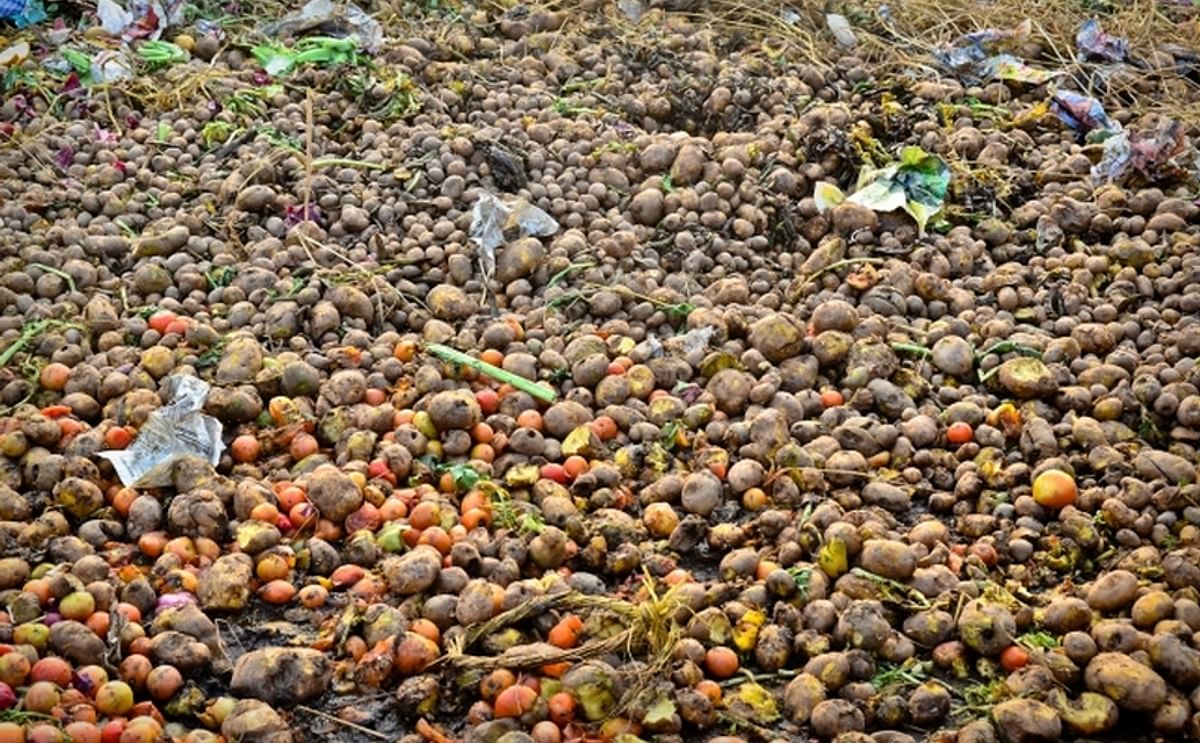Potato waste left to rot in a parking lot in India (Courtesy: MIT) Normally, you will NOT find potato waste like this. It is a very bad idea, since such a pile will spreads potato diseases! Potato waste is more commonly plowed under, used as animal feed, composted, anaerobically digested, turned into bioplastic(!) or thrown in the garbage by the end user.
United States sets Food Waste Reduction Goals

U.S. Agriculture Secretary Tom Vilsack and Environmental Protection Agency Deputy Administrator Stan Meiburg have announced the first-ever national food waste reduction goal, calling for a 50% reduction by 2030.
As part of the effort, the federal government will lead a new partnership with charitable organizations, faith-based organizations, the private sector, and local, state, and tribal governments to reduce food loss and waste in order to improve overall food security and conserve the nation’s natural resources.
“The United States enjoys the most productive and abundant food supply on earth, but too much of this food goes to waste,” said Vilsack. “An average family of four leaves more than two million calories, worth nearly $1,500, uneaten each year. Our new reduction goal demonstrates America’s leadership on a global level in getting wholesome food to people who need it, protecting our natural resources, cutting environmental pollution, and promoting innovative approaches for reducing food loss and waste.”
In 2013, the USDA and EPA launched the U.S. Food Waste Challenge, creating a platform for leaders and organizations across the food chain to share best practices on ways to reduce, recover, and recycle food loss and waste. By the end of 2014, the U.S. Food Waste Challenge had over 4,000 active participants, surpassing its initial goal of reaching 1,000 participants by 2020.
In addition to the U.S. Food Waste Challenge, the USDA has unveiled several food loss reduction initiatives over the past few years, including an app to help consumers safely store food and understand food date labels, new guidance to manufacturers on donating misbranded or sub-spec foods, and research on innovative technologies to make reducing food loss and waste cost effective.
The USDA is launching a new consumer education campaign through its Center for Nutrition Policy and Promotion with information on food loss and waste facts and reduction tips. Moreover, a new section on ChooseMyPlate.gov will educate consumers about reducing food waste to help stretch household budgets.
The USDA and EPA will also continue to encourage the private sector—foodservice companies, institutions, restaurants, grocery stores, and more—to set their own aggressive goals for reducing food loss and waste in the months ahead. Organizations such as the Consumer Goods Forum, which recently approved a new resolution to halve food waste within the operations of its 400 retailer and manufacturer members by 2025, are helping to lead the way.
As part of the effort, the federal government will lead a new partnership with charitable organizations, faith-based organizations, the private sector, and local, state, and tribal governments to reduce food loss and waste in order to improve overall food security and conserve the nation’s natural resources.
“The United States enjoys the most productive and abundant food supply on earth, but too much of this food goes to waste,” said Vilsack. “An average family of four leaves more than two million calories, worth nearly $1,500, uneaten each year. Our new reduction goal demonstrates America’s leadership on a global level in getting wholesome food to people who need it, protecting our natural resources, cutting environmental pollution, and promoting innovative approaches for reducing food loss and waste.”
In 2013, the USDA and EPA launched the U.S. Food Waste Challenge, creating a platform for leaders and organizations across the food chain to share best practices on ways to reduce, recover, and recycle food loss and waste. By the end of 2014, the U.S. Food Waste Challenge had over 4,000 active participants, surpassing its initial goal of reaching 1,000 participants by 2020.
In addition to the U.S. Food Waste Challenge, the USDA has unveiled several food loss reduction initiatives over the past few years, including an app to help consumers safely store food and understand food date labels, new guidance to manufacturers on donating misbranded or sub-spec foods, and research on innovative technologies to make reducing food loss and waste cost effective.
The USDA is launching a new consumer education campaign through its Center for Nutrition Policy and Promotion with information on food loss and waste facts and reduction tips. Moreover, a new section on ChooseMyPlate.gov will educate consumers about reducing food waste to help stretch household budgets.
The USDA and EPA will also continue to encourage the private sector—foodservice companies, institutions, restaurants, grocery stores, and more—to set their own aggressive goals for reducing food loss and waste in the months ahead. Organizations such as the Consumer Goods Forum, which recently approved a new resolution to halve food waste within the operations of its 400 retailer and manufacturer members by 2025, are helping to lead the way.
¿Te gustaría recibir noticias como esta por correo electrónico? ¡Únete y suscríbete!
Únete a nuestra Telegrama ¡Canal para actualizaciones periódicas!
Contenido Patrocinado
Contenido Patrocinado
Contenido Patrocinado
Contenido Patrocinado
Contenido Patrocinado










